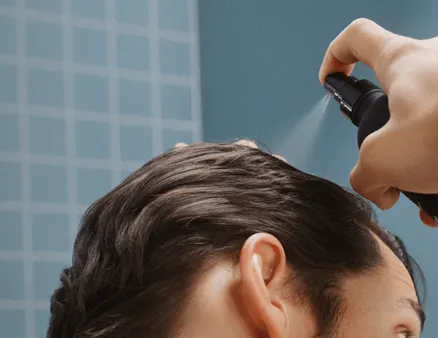Here's what we'll cover
Here's what we'll cover
Scalp reduction surgery—also called alopecia reduction surgery—is a procedure that removes balding scalp tissue and replaces it with hair-bearing scalp. This procedure has been around since the mid-1970s for the treatment of male pattern baldness (androgenic alopecia), but it can also be used to treat cicatricial alopecia (hair loss due to scalp scarring) (Unger, 1992; Sattur, 2011). Alopecia reduction can be performed alone or in combination with other hair restoration techniques, like hair transplantation; it works best for balding areas on the top of the head and is not useful for a receding hairline or frontal hair loss. Before the procedure, you should discuss the risks, benefits, and alternative treatments with your hair loss specialist.
Procedure
Scalp reduction is typically performed as an outpatient procedure, meaning that you get to go home the same day. The surgery usually begins with local injections of anesthetic (numbing medication) into your scalp, but general anesthesia can be used in some cases. Using any of a variety of incision patterns, the surgeon will cut out the balding scalp. Then the surrounding hair-bearing scalp is stretched and pulled up to cover the removed scalp and finally sutured into place. Sometimes a complementary procedure can be used to make the scalp reduction surgery more effective: scalp expansion and scalp extension.
In scalp expansion, your surgeon puts tissue expanders that look like balloons under the scalp on the sides and back of your head, where you have good hair growth. Over the next four to twelve weeks, the expanders are gradually inflated to stretch out the hair-bearing scalp. This process allows for easier closure of the scalp after the removal of the balding area. Alternatively, scalp expansion can also augment scalp reduction. This procedure is combined with a small initial scalp reduction surgery to give the surgeon access to the scalp. He or she will insert a surgical device with rubber bands under the scalp during the first small scalp reduction surgery. The tension on the rubber bands is gradually increased over the following month or two. This pulls on the hair-bearing scalp, stretching it out to allow for a second more extensive scalp reduction surgery.
The cost of scalp reduction varies greatly and depends on the surgeon, the extent of baldness to be corrected, etc. Cost estimates in the U.S. can be thousands of dollars. As this is considered cosmetic surgery, insurance companies do not cover the cost of the procedure.
Who should/should not have scalp reduction surgery?
Scalp reduction surgery is not for everyone; results depend on your degree and pattern of hair loss, along with other factors. After a consultation with a hair loss specialist, you can discuss whether you are a good candidate for this procedure.
Candidates for scalp reduction surgery have the following characteristics:
Over 40 years old
Dense hair on the sides and back of the head (donor hair)
Healthy stretchy scalp skin
Hair loss due to genetics (androgenic alopecia)
People who should avoid this surgery include those with (Sattur, 2011):
Tight, inelastic scalp skin
Thinning hair on sides and back of the head
A balding area that still has a substantial amount of hair (better managed with medical treatment, such as minoxidil)
Hair loss that is progressing
Hair loss that is temporary and due to stress, hormones, illness, etc.
Oral Minoxidil Important Safety Information: Read more about serious warnings and safety info.
Risks of scalp reduction surgery
As with any surgery, you should discuss the risks and benefits of the procedure with your surgeon. The risks or side effects include:
Bleeding
Infection
An unnatural appearance of hair; your hairline or direction of hair growth may look different
Numbness or tingling of the scalp
Accelerated hair loss: often your hair in the area of the surgery falls out within a few weeks postoperatively; this hair usually grows back, but it may not in some cases
Stretch-back: this occurs in all cases but to varying degrees. It is a re-expansion of the balding area and is due to the stretched scalp that was stitched together, losing its tightness. The balding area can regrow by 10-50% due to stretch-back (Sattur, 2011).
Lack of blood flow causing the newly repositioning scalp not to grow well
Lack of enough donor hair for future hair restoration procedures
Expectations and recovery
After scalp reduction surgery, you should avoid strenuous physical activity for at least three weeks. You will likely need to see your surgeon several times throughout the postoperative period. You can expect some pain, swelling, and bruising; be sure to discuss any warning signs with your surgeon before the procedure. You may notice that your hair falls out about six weeks after surgery; this is usually temporary, and the new hair should grow back after another six weeks. Some people need a “touch-up” or revision after surgery; for example, to fix an unsightly scar or perform a hair transplant to fill in thin areas.
It is essential to have realistic expectations for any cosmetic procedure. If you are young, with mild hair loss that is still progressing and you don’t want to have scarring on your head, then this procedure is not right for you. Discuss your expectations with a hair loss specialist before having any procedures so that you can make an informed decision. Keep in mind that scalp reduction only decreases the bald area that is present at the time of surgery; it does not prevent future balding or hair loss that may occur with age.
You can learn more about hair loss treatments by clicking here.
DISCLAIMER
If you have any medical questions or concerns, please talk to your healthcare provider. The articles on Health Guide are underpinned by peer-reviewed research and information drawn from medical societies and governmental agencies. However, they are not a substitute for professional medical advice, diagnosis, or treatment.
Sattur, S. (2011). A review of surgical methods (excluding hair transplantation) and their role in hair loss management today. Journal of Cutaneous and Aesthetic Surgery , 4 (2), 89. doi: 10.4103/0974-2077.85020. Retrieved from https://www.jcasonline.com/article.asp?issn=0974-2077;year=2011;volume=4;issue=2;spage=89;epage=97;aulast=Sattur
Unger, M. G. (1992). Scalp reduction. Clinics in Dermatology , 10 (3), 345–355. doi: 10.1016/0738-081x(92)90078-d. Retrieved from https://www.cidjournal.com/article/0738-081X(92)90078-D/pdf










